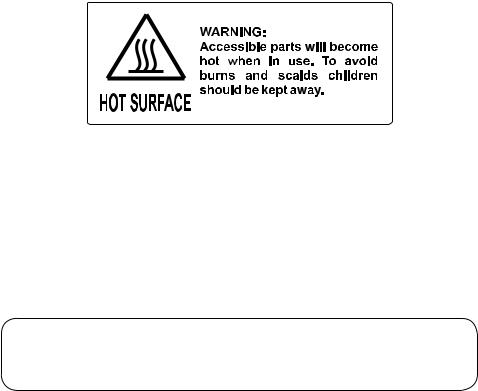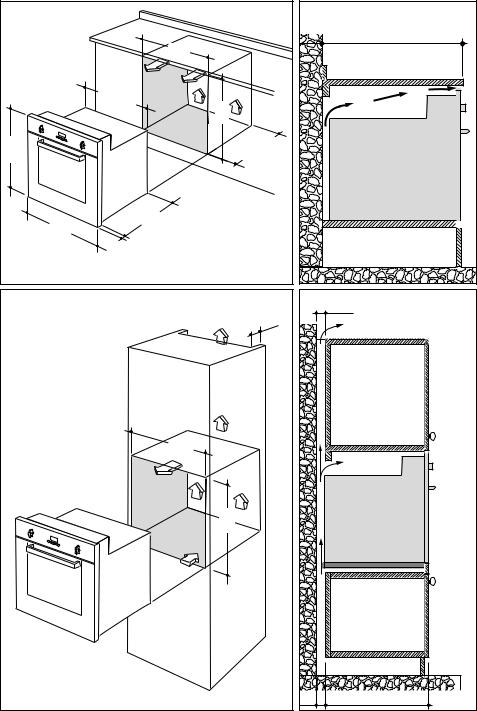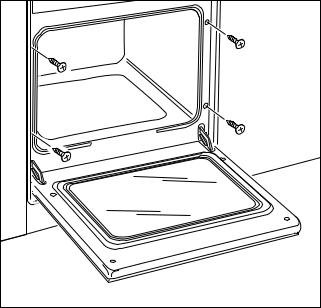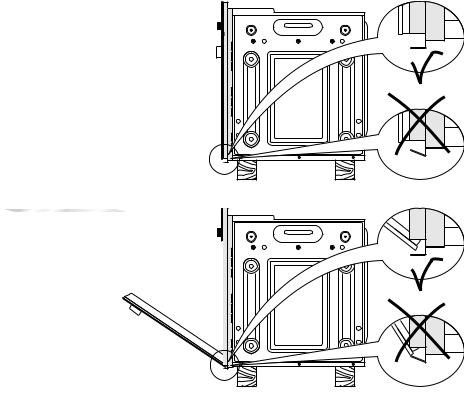Delonghi DEL607M Installation and Operation Guide

DE’LONGHI
COOKING
INSTALLATION and SERVICE INSTRUCTIONS
USE and CARE INSTRUCTIONS
DEL607M
MULTIFUNCTION BUILT-IN OVEN
distributed by
DeLonghi Australia Pty Ltd
DeLonghi New Zealand Ltd

Dear Customer,
Thank you for having purchased and given your preference to our product.
The safety precautions and recommendations reported below are for your own safety and that of others. They will also provide a means by which to make full use of the features offered by your appliance.
Please keep this booklet in a safe place. It may be useful in future, either to yourself or to others in the event that doubts should arise relating to its operation.
This appliance must be used only for the task it has explicitly been designed for, that is for cooking foodstuffs. Any other form of usage is to be considered as inappropriate and therefore dangerous.
The manufacturer declines all responsibility in the event of damage caused by improper, incorrect or illogical use of the appliance or be faulty installation.
This appliance has been designed and constructed in accordance with the following codes and specifications:
AS/NZS 60335.1 General Requirements for Domestic electrical appliances
AS/NZS 60335.2.6 Particular Requirements for Domestic electrical cooking appliances AS/NZS CISPR 14.1 Electromagnetic Compatibility Requirements.
PRODUCT LABEL
2

IMPORTANT SAFETY PRECAUTIONS AND RECOMMENDATIONS
IMPORTANT: This appliance is designed and manufactured solely for the cooking of domestic (household) food and is not suitable for any non domestic application and therefore should not be used in a commercial environment.
The appliance guarantee will be void if the appliance is used within a non domestic environment i.e. a semi commercial, commercial or communal environment.
Read the instructions carefully before installing and using the appliance.
•After having unpacked the appliance, check to ensure that it is not damaged and that the oven door closes correctly.
In case of doubt, do not use it and consult your supplier or a professionally qualified technician.
•Packing elements (i.e. plastic bags, polystyrene foam, nails, packing straps, etc.) should not be left around within easy reach of children, as these may cause serious injuries.
•Some appliances are supplied with a protective film on steel and aluminium parts. This film must be removed before using the appliance.
•IMPORTANT: The use of suitable protective clothing/gloves is recommended when handling or cleaning this appliance.
•Do not attempt to modify the technical characteristics of the appliance as this may become dangerous to use. The manufacturer declines all responsibility for any inconvenience resulting from the inobservance of this condition.
•Do not operate your appliance by means of an external timer or separate remote-control system.
•Do not carry out cleaning or maintenance operations on the appliance without having previously disconnected it from the electric power supply.
•WARNING: Ensure that the appliance is switched off before replacing the oven lamp to avoid the possibility of electric shock.
3
•Do not use a steam cleaner because the moisture can get into the appliance therefore making it unsafe.
•Do not touch the appliance with wet or damp hands (or feet).
•Do not use the appliance whilst in bare feet.
•If you should decide not to use this appliance any longer (or decide to substitute another model), before disposing of it, it is recommended that it be made inoperative in an appropriate manner in accordance to health and environmental protection regulations, ensuring in particular that all potentially hazardous parts be made harmless, especially in relation to children who could play with unused appliances.
•The various components of the appliance are recyclable. Dispose of them in accordance with the regulations in force in your country. If the appliance is to be scrapped, remove the power cord.
•After use, ensure that the knobs are in the off position.
•Children less than 8 years of age shall be kept away unless continuously supervised.
•This appliance can be used by children aged from 8 years and above and persons with reduced physical, sensory or mental capabilities or lack of experience and knowledge if they have been given supervision or instruction concerning use of the appliance in a safe way and understand the hazards involved. Children shall not play with the appliance. Cleaning and user maintenance shall not be made by children without supervision.
•The manufacturer declines all liability for injury to persons or damage to property caused by incorrect or improper use of the appliance.
•WARNING: During use the appliance and its accessible parts become hot; they remain hot for some time after use.
––Care should be taken to avoid touching heating elements inside the oven.
––The door is hot, use the handle.
––To avoid burns and scalds, young children should be kept away.
•Make sure that electrical cables connecting other appliances in the
proximity of the oven cannot become entrapped in the oven door.
4
•WARNING: When correctly installed, your product meets all safety requirements laid down for this type of product category. However special care should be taken around the rear or the underneath of the appliance as these areas are not designed or intended to be touched and may contain sharp or rough edges, that may cause injury.
•FIRSTUSEOFTHEOVEN-itisadvisedtofollowtheseinstructions:
––Furnish the interior of the oven as described in the chapter “CLEANING AND MAINTENANCE”.
––Switch on the empty oven on max to eliminate grease from the heating elements.
––Disconnect the appliance from the electrical power supply, let the oven cool down and clean the interior of the oven with a cloth soaked in water and neutral detergent; then dry carefully.
•CAUTION: Do not use harsh abrasive cleaners or sharp metal scrapers to clean the oven door glass since they can scratch the surface, which may result in shattering of the glass.
•Do not line the oven walls with aluminium foil. Do not place baking trays or the drip tray on the base of the oven chamber.
•FIRE RISK! Do not store flammable material in the oven.
•Always use oven gloves when removing the shelves and food trays from the oven whilst hot.
•Do not hang towels, dishcloths or other items on the appliance or its handle – as this could be a fire hazard.
•Clean the oven regularly and do not allow fat or oils to build up in the oven base or tray. Remove spillages as soon as they occur.
•Do not stand on the open oven door.
•Always stand back from the appliance when opening the oven door to allow steam and hot air to escape before removing the food.
•SAFE FOOD HANDLING: Leave food in the oven for as short a time as possible before and after cooking. This is to avoid contamination by organisms which may cause food poisoning. Take particular care during warmer weather.
•WARNING: Take care NOT to lift the appliance by the door handle.
5

INSTALLATION
CAUTION:
■■ This appliance must be installed in accordance with these installation instructions. ■■ This appliance shall only be serviced by authorised personnel.
■■ This appliance is to be installed only by an authorised person in compliance with the current electrical regulations and in observation of the instructions supplied by the manufacturer.
Failure to comply with this condition will render the guarantee invalid.
■■ Incorrect installation, for which the manufacturer accepts no responsibility, may cause personal injury of damage.
■■ Always disconnect the appliance from mains power supply before carrying out any maintenance operations or repairs.
FITTING REQUIREMENTS
■■ The oven can be fitted in standard units, 60 cm width and depth.
■■ Installation requires a compartment as illustrated in figures 1a and 2a.
■■ Fitting the oven into a base: Arrangements should be made for an adequate supply of the air to the oven to avoid overheating (fig. 1b).
■■ Fitting the oven into a column:Itisnecessarythattheovenisprovidedwithachimney as per fig. 2b. If the column unit reaches the ceiling an outlet must be provided through which air can flow to the outside
■■ On the lower side, the oven must lay on supports standing the oven weight.
■■ Remember the housing should not be free standing but be secured to the wall and/or adjacent fittings.
■■ We would point out that the adhesive which bonds the plastic laminate to the furniture must withstand temperatures not less than 150° C to avoid delamination.
■■ The walls of the units must be capable of resisting temperatures of 75 °C above room temperature.
■■ Do not seal the oven into the cabinetry with silicone or glue; this makes future servicing difficult. Delonghi will not cover the costs of removing the oven, or of damage caused by this removal.
■■ The walls surrounding the oven must be made of heat-resistant material. ■■ WARNING: Taking care NOT to lift the oven by the door handle.
WARNING
When correctly installed, your product meets all safety requirements laid down for this type of product category.
However special care should be taken around the rear or the underneath of the appliance as these areas are not designed or intended to be touched and may contain sharp or rough edges, that may cause injury.
IMPORTANT
Some environmental factors and cooking habits can cause condensation in and around the oven during use. To protect surrounding cabinetry from possible damage caused by frequent or excessive condensation, we recommend moisture-proofing the oven cavity.
6

Figure 1a |
|
|
|
|
|
|
|
560 |
|
|
536 |
min |
195 |
|
|
|
|
||
|
|
|
|
|
495 |
|
|
550 |
min |
|
|
|
||
|
|
|
|
|
594 |
|
|
540 |
|
|
|
|
|
|
|
20 |
|
|
|
Figure 2a |
50 |
560 |
585 |
Figure 1b
|
600 |
50 mm |
Figure 2b |
50 |
550 |
7

FIXING THE OVEN
Introduce the oven into the furniture opening and fix it with 4 screws (not supplied) as figure
3. It is essential that the oven rests on a surface which will support its weight, as the screw fixing is only complementary.
Note
It is essential that when installing your oven adequate air circulation is allowed for within the installation. See figures 1a, 1b, 2a, 2b.
Inadequate air circulation may greatly impair the performance of your oven and may effect adjacent cabinets due to an increase in temperature.
Caution!
Do not lift this oven by the door handle.
Adjust the hinges of furniture doors adjacent to the oven to allow a 4-5 mm gap between the furniture door and the oven frame.
Figure 3
8

Figure 4
OvenVEN DOORDoor
LOWERowerTRIMrim
AIRAirFLOWFlow
IMPORTANT:
Please take extra care not to damage the lower trim of the oven.
Ensure the oven sits on wooden blocks or similar supports when it is removed from the carton as shown in above diagram. This will prevent any damage to the lower trim.
Should the lower trim become damaged, straighten the trim and ensure the oven door opens fully without obstruction from the lower trim.
After installation check the lower trim is still undamaged.
The space between the bottom of the door & the lower trim is important to allow proper air circulation into the oven.
The oven door should be opened slowly to it’s fully open position ensuring there is adequate clearance between the bottom of the door and the lower trim.
The manufacturer does not accept responsibility for any damage to the oven resulting from incorrect installation.
9
ELECTRICAL REQUIREMENTS
■■ The appliance must be connected to the mains checking that the voltage corresponds to the value given in the rating plate and that the electrical cable sections can withstand the load specified on the plate.
■■ A suitable isolating switch providing full disconnection from the mains power supply shall be incorporated in the permanent wiring, mounted and positioned to comply with the local wiring rules and regulations. The isolating switch must be of an approved type and provide a 3 mm air gap contact separation in all poles (or in all active [phase] conductors if the local wiring rules allow for this variation of the requirements).
■■ The isolating switch shall be easily accessible to the customer with the oven installed.
■■ The power supply cable must not touch the hot parts and must be positioned so that it does not exceed 75°C above ambient.
■■ The oven is supplied without a power supply plug and therefore if you are not connecting directly to the mains, a standardized plug suitable for the load must be fitted.
■■ The plug must be connected to an earthed socket in compliance with safety standards.
■■ To connect the appliance to the mains electricity supply, do not use adapters, reducers or branching devices as they can cause overheating and burning.
■■ Once the appliance has been installed, the switch or socket must always be accessible.
■■ If the supply cord is damaged it must be replaced by the manufacturer or it’s Service
Agent or a similarly qualified person in order to avoid a hazard.
N.B. The connection of the appliance to earth is mandatory.
If the installation requires alterations to the domestic electrical system call a qualified electrician. He should also check that the domestic electrical system is suitable for the power drawn by the appliance.
Replacing the power cord must be done by a qualified electrician in accordance with the instructions supplied by the manufacturer and in compliance with established electrical regulations.
10

REPLACING THE POWER SUPPLY CABLE
Important! This appliance must be connected to the electricity supply only by an authorised person.
To connect the supply cable:
■■ Unhook the terminal board cover by inserting a screwdriver into the two hooks “A” (fig. 5).
■■ Open the cable gland by unscrewing screw “F” (fig. 6), unscrew the terminal screws and remove the cable.
■■ The new supply cable, of suitable type and section, is connected to the terminal board following the diagram fig. 7.
■■ Close and hook again the terminal board cover.
N.B. The earth conductor must be left about 3 cm longer than the others.
VOLTAGE AND POWER CONSUMPTION
220-240 V ac |
2350 W (10.21 A) |
Figure 5 |
|
|
FEEDER CABLE SECTION TYPE H05RR-F
3 x 1,5 mm2 (*) (**)
(*) Connection possible with plug and outlet (**) Connection with wall box connection.
A
Figure 6 |
Figure 7 |
F |
220 - 240 V ac
L1 N (L2)
E
11
